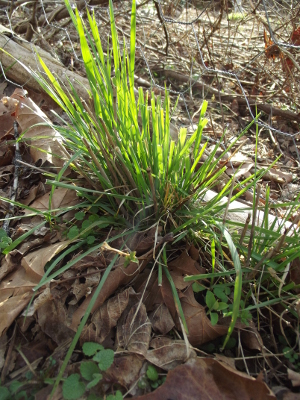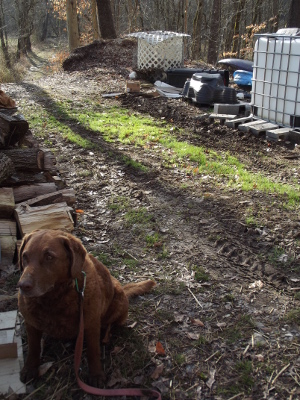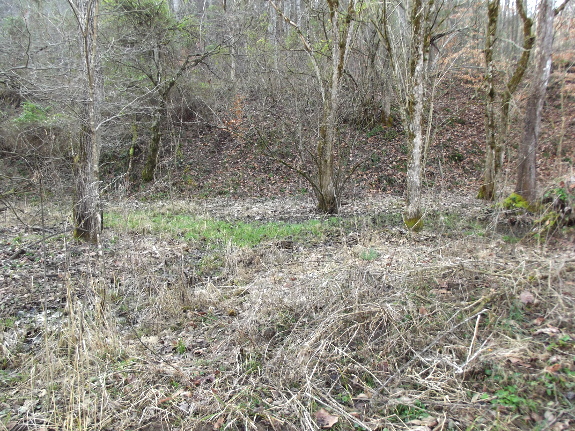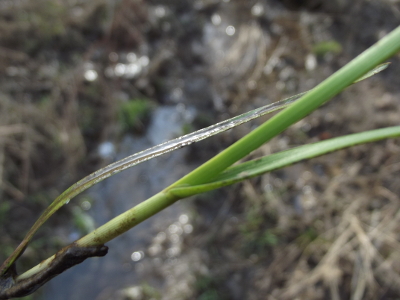
Grasses begin to grow again
 Even though chickens get most
of their nutrition from insects and
seeds, tender young plants provide lots of vitamins and minerals (and a
surprising amount of protein). That's why I was thrilled to
notice grasses beginning to grow in several spots around the farm in
the last week.
Even though chickens get most
of their nutrition from insects and
seeds, tender young plants provide lots of vitamins and minerals (and a
surprising amount of protein). That's why I was thrilled to
notice grasses beginning to grow in several spots around the farm in
the last week.
One of our newest
pastures is under the trees where "normal" grasses seldom grow.
However, a few clumps of bunchgrasses are evident. The chickens
ate them down to nubbins, but this clump has already started to regrow
in the last week since the chickens were turned out of the
pasture. Does anyone have a clue what kind of grass this might be?
I'm relatively sure that
the tender-leaved grasses that pop up in closely mown parts of our yard
and in the treeless pastures are bluegrass. Bluegrass feels
delightful to bare feet, and  also stays tender enough for
chickens to enjoy even in the summer, so I'm pleased it sprouts
anywhere we open up the canopy and mow regularly.
also stays tender enough for
chickens to enjoy even in the summer, so I'm pleased it sprouts
anywhere we open up the canopy and mow regularly.
New bluegrass leaves
started to push up through the dead brown litter in the garden aisles a
week or so ago, but regrowth started sooner in more protected
areas. For example, this patch of green is underneath where we
usually park the truck --- I assume that big old hunk of metal
mitigated some of winter's cold and let the grass grow faster.
But the most vigorous
early spring grasses aren't in our cultivated areas at all. I
looked out across the floodplain on Monday and noticed a huge patch of
green in what we fondly term "the alligator swamp" --- a waterlogged
oxbow off our creek.

 I don't know if these
water-loving grasses are a species that always gets a jumpstart on
spring, or whether the thermal mass of the water is responsible for the
vibrant greenery. But maybe that explains why the chickens have
been hanging out in the damp area on the far side of the barn rather
than following the sun in the early morning the way they did a few
months ago.
I don't know if these
water-loving grasses are a species that always gets a jumpstart on
spring, or whether the thermal mass of the water is responsible for the
vibrant greenery. But maybe that explains why the chickens have
been hanging out in the damp area on the far side of the barn rather
than following the sun in the early morning the way they did a few
months ago.
Learning the patterns of
grass growth is essential to proper pasturing. For example, I'm
planning all of my broilers to hit the ground running just as the grass
is reaching its peak. However, I've still got a long way to go
before I thoroughly understand our sod, and grass species ID is
clearly near the top of the to-learn list. Has anyone tried out
various grass field guides and settled on one that helps from a
pasturing point of view?
Want more in-depth information? Browse through our books.
Or explore more posts by date or by subject.
About us: Anna Hess and Mark Hamilton spent over a decade living self-sufficiently in the mountains of Virginia before moving north to start over from scratch in the foothills of Ohio. They've experimented with permaculture, no-till gardening, trailersteading, home-based microbusinesses and much more, writing about their adventures in both blogs and books.
Want to be notified when new comments are posted on this page? Click on the RSS button after you add a comment to subscribe to the comment feed, or simply check the box beside "email replies to me" while writing your comment.

I have several books, but they are geared towards the native grasses of Texas, and also seem pretty academic rather than practical. What I have gleaned so far is that for most identification, you need to look at the flower / seed structures.
If you find a good general one, make sure and post!